Email Marketing for Hotels: Drive Direct Bookings and Guest Loyalty
Oct 3, 2025
 Mika Takahashi
Mika TakahashiPopular Categories
Hotel Technology & InnovationHotel Operations OptimizationDigital MarketingIndustry TrendsRevenue ManagementHospitality Industry
Popular Categories
Trending Post
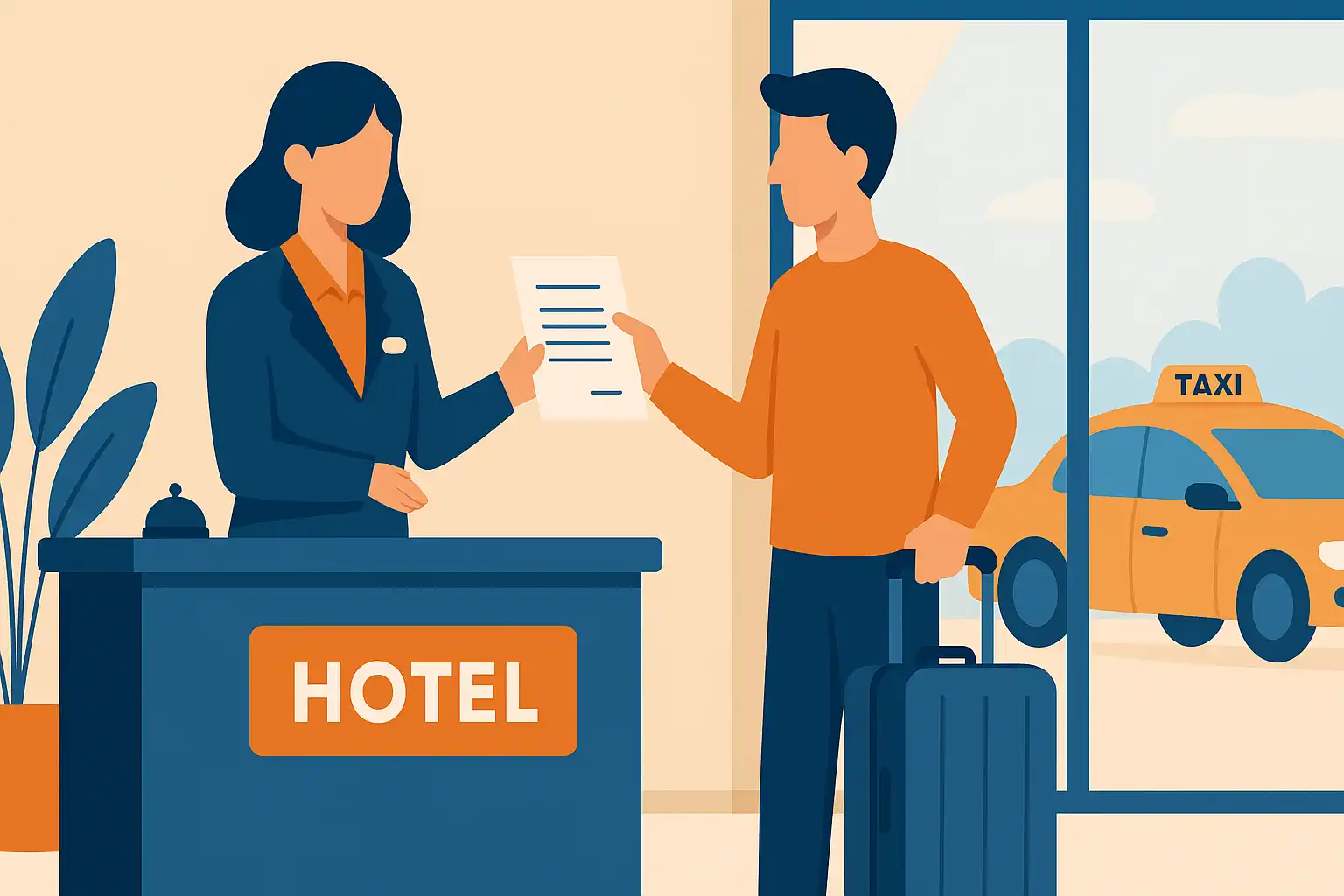
Hotel Walk Letter Template: Professional Guest Communication
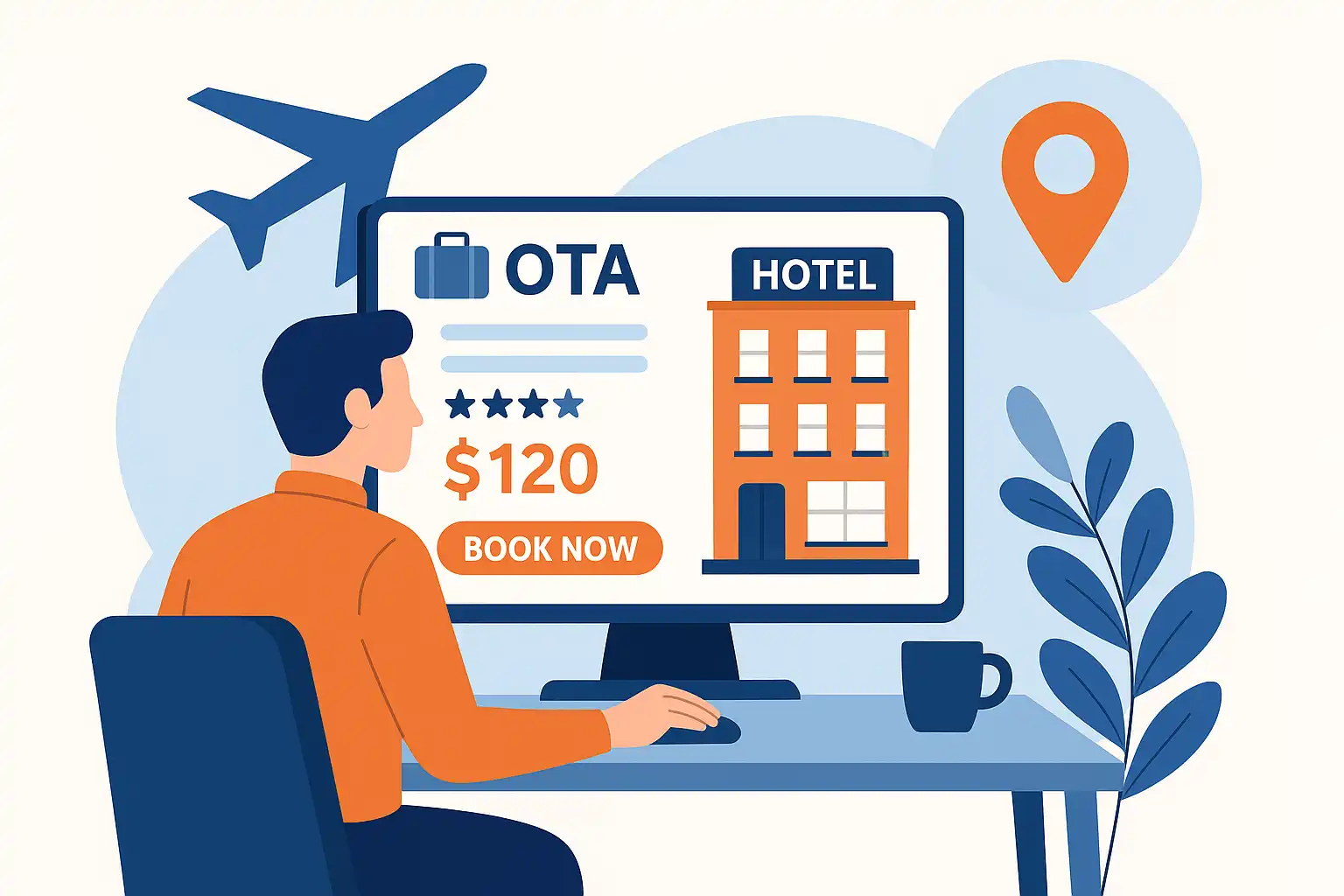
Online Travel Agents: What They Are and How They Work
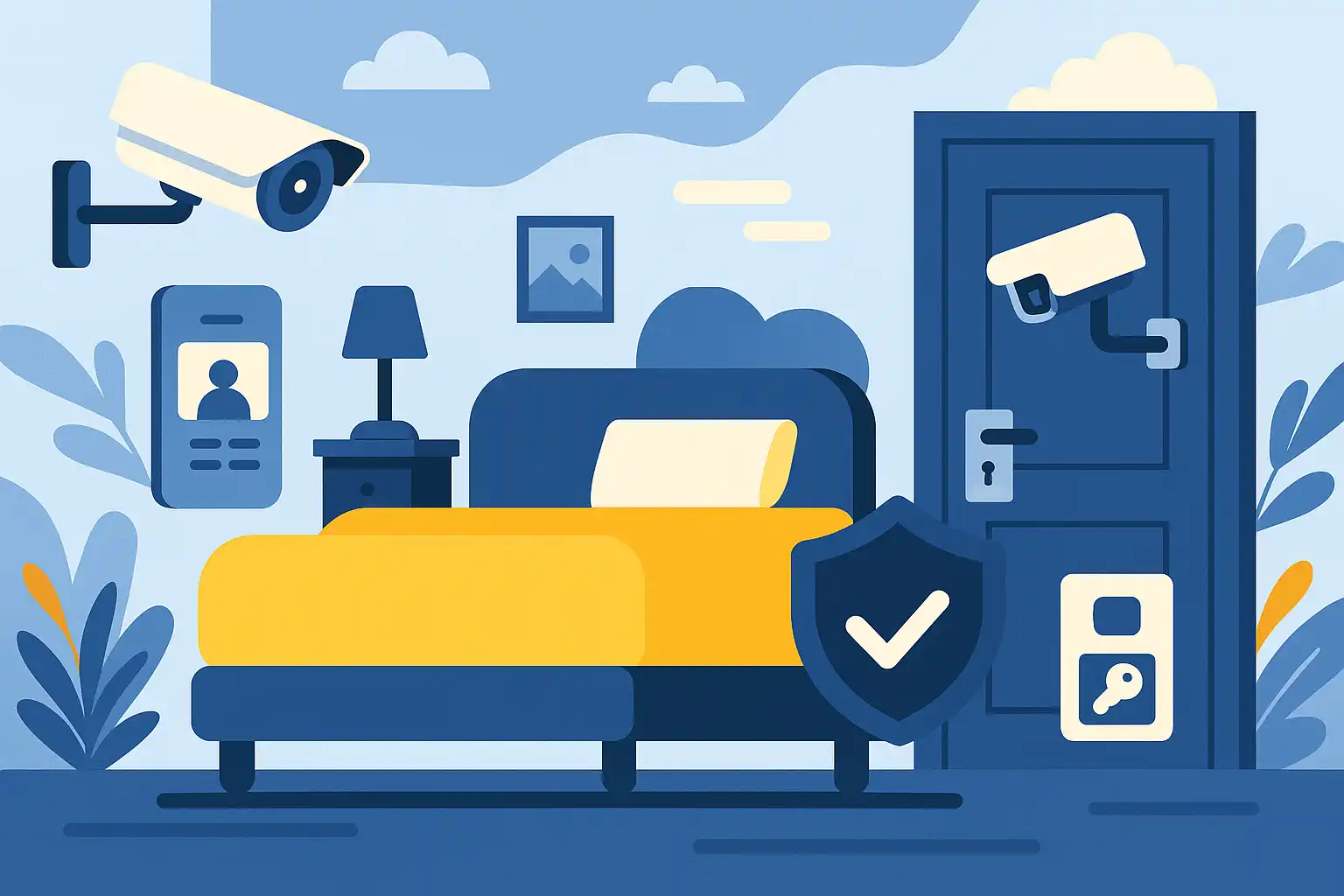
Hotel Security Systems: Modern Protection Solutions

Hotel Advertising: Complete Guide to Boost Bookings and Revenue
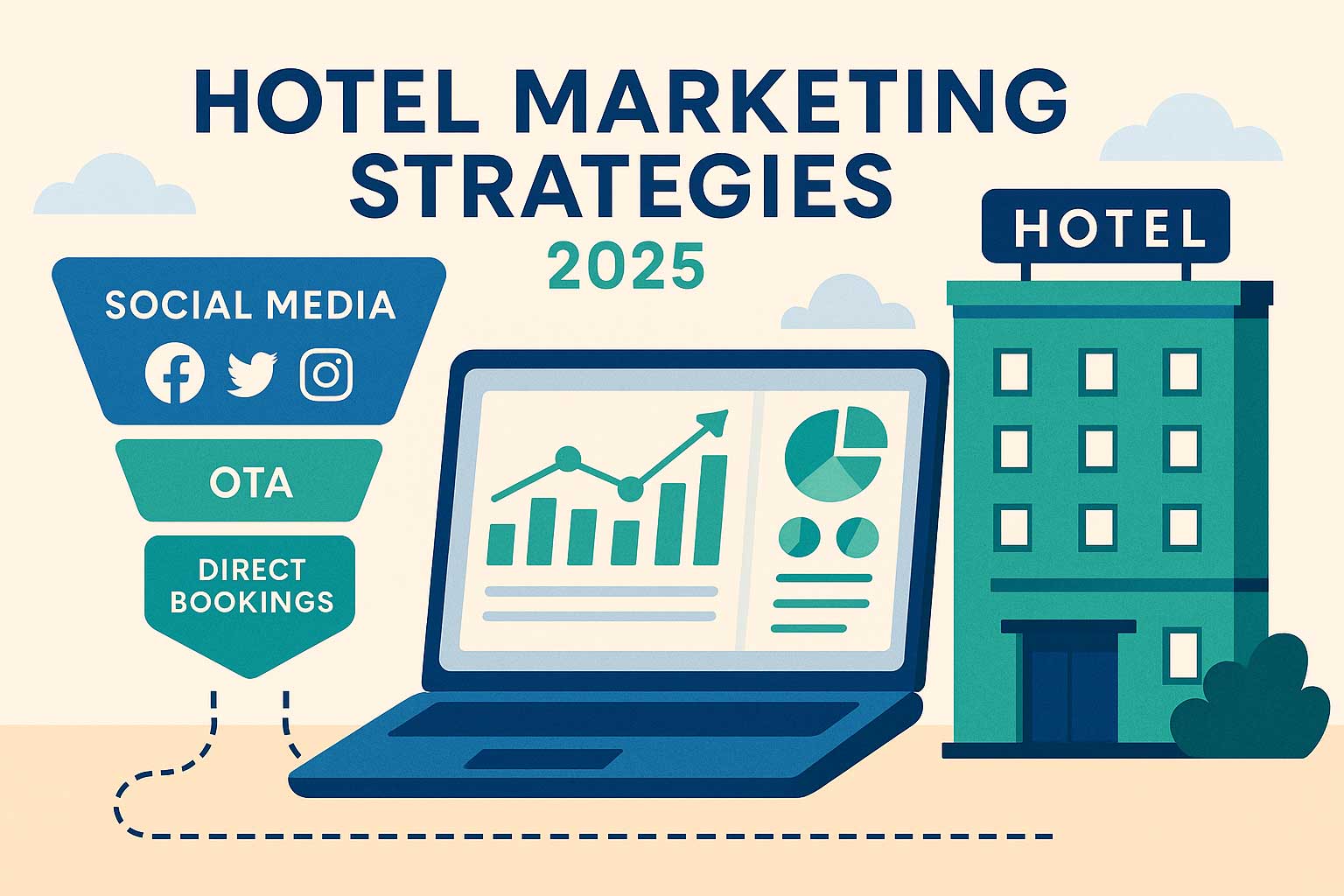
25 Hotel Marketing Strategy Ideas for 2025: Complete Guide

AI Reservation Agent: Revolutionizing Hotel Booking and Guest Experience

PMS Communication: Streamlining Property Management Through Effective Guest Messaging
Table of contents
Hotels are losing up to 25% of their revenue to online travel agencies through commission fees, making direct bookings more critical than ever before. While OTAs control guest relationships and charge hefty fees, email marketing gives hotels the power to communicate directly with guests and build lasting relationships that drive profitable repeat business.
Email marketing for hotels delivers an exceptional return on investment, generating an average of $42 for every $1 spent - significantly outperforming social media, paid search, and other hotel digital marketing channels. With 4.48 billion email users worldwide, email remains the most effective way to reach travelers across all demographics and drive them to book directly through your hotel website.
This comprehensive guide will show you how to build a successful hotel email marketing strategy that reduces OTA dependency, increases guest loyalty, and maximizes your hotel revenue through targeted, personalized communication.
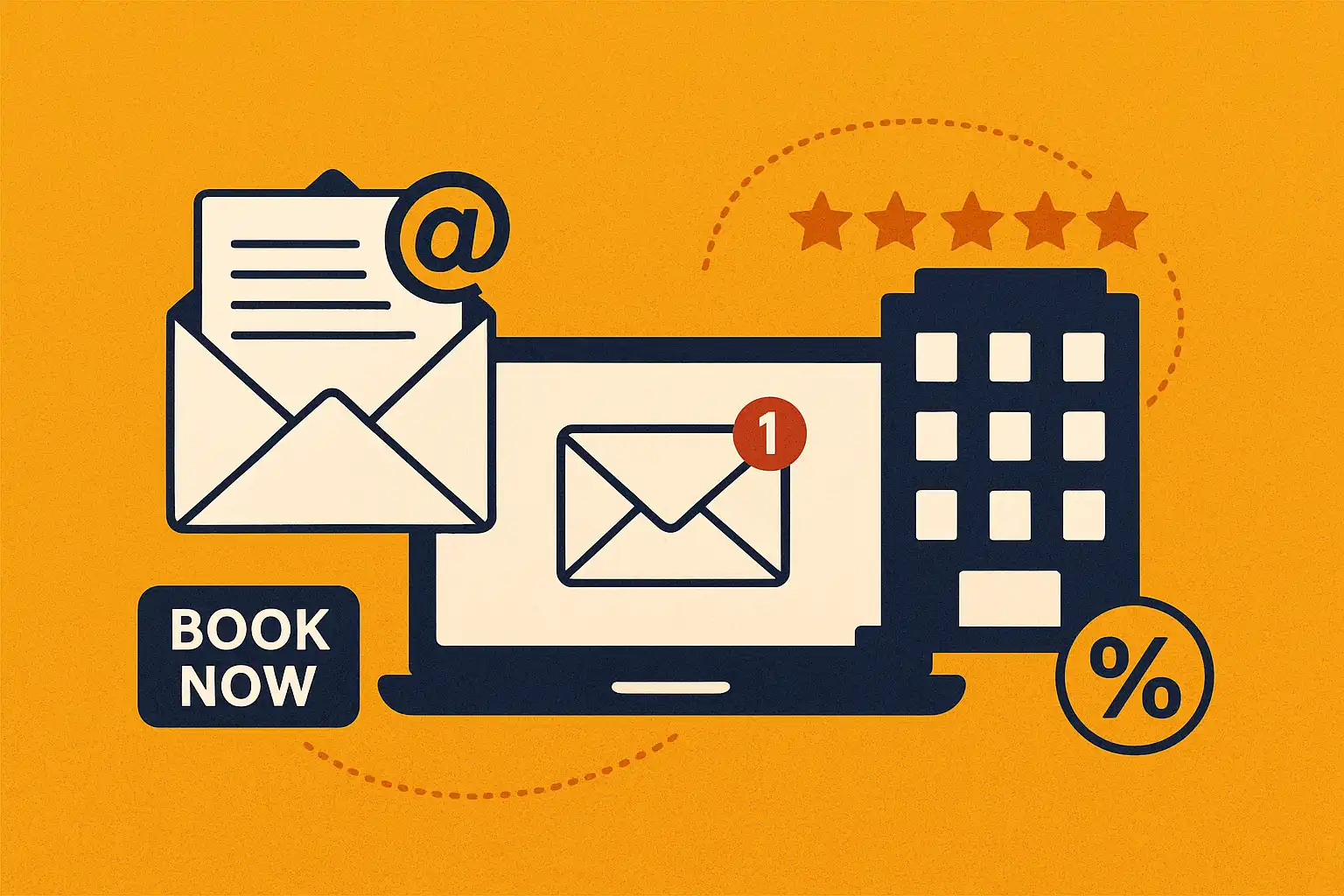
What is Email Marketing for Hotels and Why It Matters
Hotel email marketing is a direct communication strategy that sends targeted messages to past, current, and potential guests to drive bookings and build relationships. Unlike traditional marketing approaches, email marketing allows hotels to own the guest relationship and communicate value propositions without paying commission fees to third-party platforms.
The hospitality industry faces unique challenges that make email marketing particularly valuable. Online travel agencies dominate the booking landscape, capturing guest data and charging commission rates between 15-25% on every reservation. This creates a significant drain on hotel revenue while limiting direct guest relationships.
Email marketing addresses these challenges by creating a direct line of communication with guests. Hotels can use email campaigns to showcase their unique value propositions, promote special offers, and encourage guests to book directly through their website. This strategy not only reduces commission costs but also allows hotels to gather valuable guest data and preferences for future marketing efforts.
Email delivers an average ROI of $38-42 for every $1 spent, outperforming social media, paid search, and other digital marketing channels. For hotels, this return is often even higher due to the high lifetime value of repeat guests and the significant savings from avoiding OTA commissions. Well-executed hotel email marketing campaigns regularly achieve open rates between 25-46% and click-through rates of 3-5%, with top-performing segmented campaigns exceeding these industry averages.
With 4.48 billion email users worldwide in 2024, email remains the most effective channel for reaching travelers across all demographics. Unlike social media platforms where organic reach continues to decline, email provides direct access to your audience’s inbox, ensuring your message reaches its intended recipients.
The key to successful email marketing for hotels lies in understanding the guest journey and delivering relevant, timely content that enhances the travel experience while driving profitable actions.
Building Your Hotel Email Database: Foundation for Success
Your email database forms the foundation of all hotel email marketing efforts. Without a robust list of engaged subscribers, even the most creative campaigns will fail to deliver results. Building a quality email list requires strategic planning, multiple touchpoints, and compelling incentives that motivate guests to share their contact information.
The most effective approach involves implementing email capture forms throughout the guest journey, from initial website visits to post-stay follow-up. Your hotel website should feature multiple opportunities for visitors to join your email list, including homepage signup forms, booking confirmation pages, and dedicated contact pages. Rather than simply asking for newsletter subscriptions, offer value-driven incentives that appeal to travelers.
Successful incentives include early check-in privileges, complimentary room upgrades, exclusive access to special rates, or local attraction discounts. For example, instead of “Subscribe to our newsletter,” try “Become a VIP member for exclusive deals and early check-in privileges.” This approach positions email signup as a valuable loyalty program rather than another marketing message.
Collect emails at multiple touchpoints throughout the guest experience. Front desk staff should capture email addresses during check-in, while restaurant and spa reservations provide additional opportunities to expand your database. Event registrations, WiFi login pages, and concierge interactions all present natural moments to request contact information.
Ensure GDPR compliance by using double opt-in processes and clearly stating how guest data will be used. Your signup forms should include transparent language about email frequency, content types, and data protection policies. This transparency builds trust with potential guests and reduces the likelihood of spam complaints or unsubscribes.
Import existing customer data from your property management system, CRM, and booking systems while respecting privacy regulations and obtaining proper consent. Many hotels discover they already have extensive guest databases that simply need proper organization and compliance updates to become effective email marketing assets.
Consider implementing progressive profiling techniques that gather additional guest information over time. Initial signup forms should request minimal information to reduce friction, while subsequent emails can gather preferences, travel patterns, and interests through engaging surveys or preference centers.
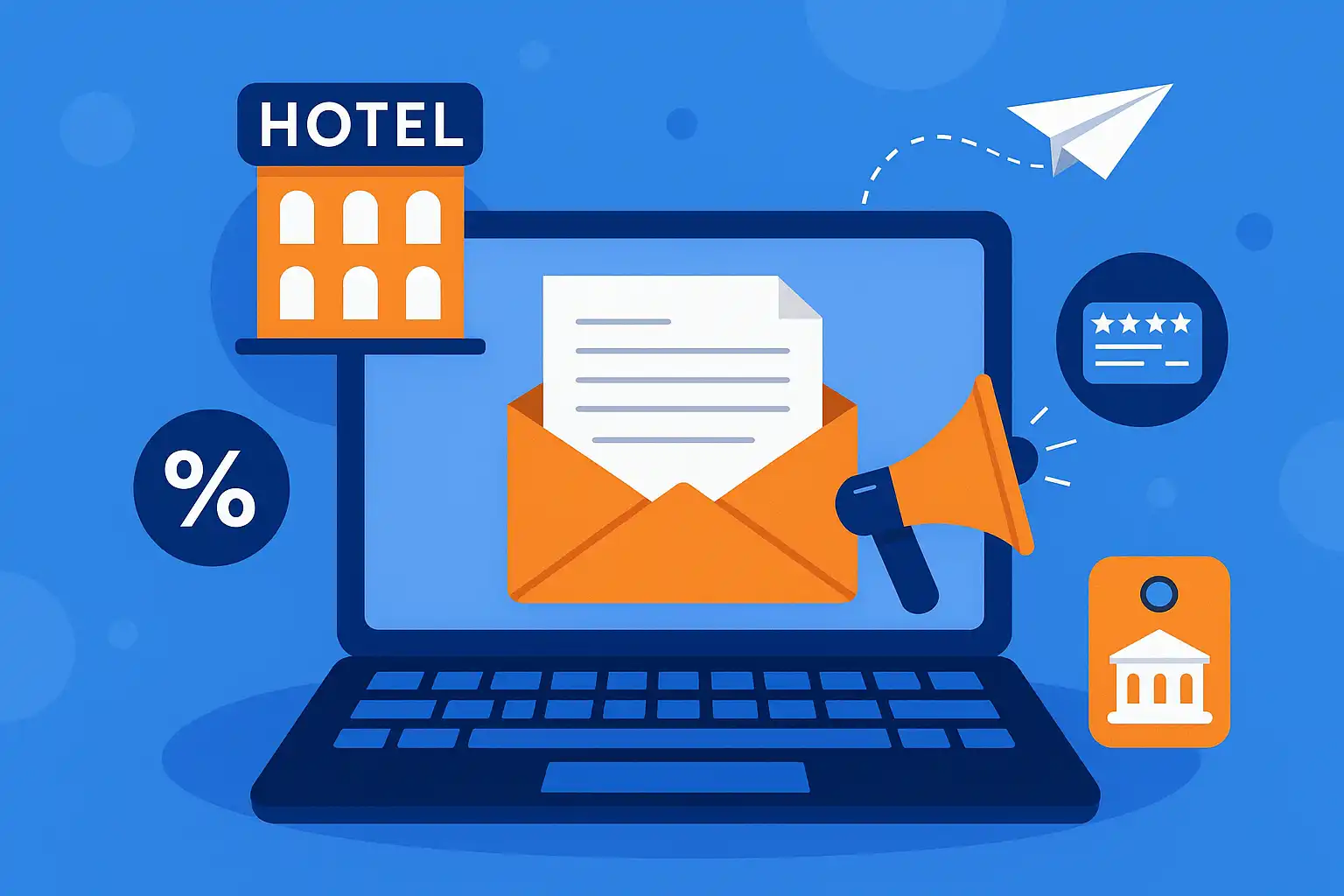
Essential Email Campaign Types for Hotels
Pre-Arrival Email Sequence
Pre-arrival emails set the stage for exceptional guest experiences while creating opportunities for additional revenue through upselling and cross-selling. This sequence begins immediately after booking confirmation and continues until guest arrival, providing valuable information while building anticipation for the upcoming stay.
Send booking confirmations immediately with reservation details, contact information, and links to modify bookings. These transactional emails achieve the highest open rates and provide the foundation for ongoing communication. Include clear confirmation numbers, arrival and departure dates, room type details, and any special requests or packages purchased.
Follow up 7 days before arrival with local weather forecasts, nearby attractions, and upgrade opportunities. This email positions your hotel as a helpful local expert while creating upselling opportunities. Include information about seasonal activities, local events during their stay, and exclusive upgrade offers for VIP guests or loyalty program members.
Send another email 24-48 hours before check-in with practical arrival information including parking instructions, WiFi details, and mobile check-in options. This communication reduces front desk workload while enhancing guest convenience. Include maps, transportation options, and any COVID-related protocols or updates.
Include personalized recommendations based on guest preferences collected during booking. Business travelers might receive information about meeting rooms and business center amenities, while leisure guests could learn about spa treatments, local restaurants, or family-friendly activities. This personalization demonstrates attention to detail and increases the likelihood of additional purchases.
On-Property Engagement Emails
On-property engagement emails enhance the guest experience while driving additional revenue through strategic upselling and cross-selling. These communications should feel helpful rather than sales-focused, positioning your hotel as a knowledgeable host dedicated to guest satisfaction.
Send welcome emails within 2 hours of check-in highlighting hotel amenities, restaurant hours, and concierge services. Include a digital property map, amenity schedules, and contact information for various departments. This email reduces guest questions while ensuring they’re aware of all available services and amenities.
Daily digest emails featuring hotel events, local happenings, and weather updates keep guests informed while encouraging exploration. Include information about live music, special dining menus, spa promotions, or nearby festivals and attractions. These emails should feel like insider tips from a knowledgeable friend rather than marketing messages.
Upselling emails for spa treatments, dining reservations, or room service during mid-stay periods can significantly increase average booking value. Target these offers based on guest behavior and preferences. Guests who booked standard rooms might receive upgrade offers, while those staying multiple nights could be interested in spa packages or special dining experiences.
Emergency or important update emails regarding hotel services, weather alerts, or local transportation changes demonstrate care for guest safety and convenience. These communications build trust and position your hotel as a reliable source of information during their stay.
Post-Stay Follow-Up Campaigns
Post-stay follow-up campaigns maintain guest relationships, encourage reviews, and drive future bookings. This sequence begins immediately after checkout and can continue for months, nurturing relationships with past guests while identifying opportunities for repeat visits.
Thank you emails sent within 24 hours of checkout with feedback survey links and social media sharing opportunities show appreciation while gathering valuable insights. Include photos from their stay, personalized messages referencing specific services used, and easy sharing options for social media platforms.
Review request emails 3-5 days post-stay with direct links to Google, TripAdvisor, and booking platform review pages help build online reputation while the experience remains fresh in guests’ minds. Make this process as simple as possible by providing direct links and suggesting specific aspects of their stay to mention.
Win-back campaigns 30-60 days later featuring special return guest discounts or loyalty program benefits re-engage past guests when they’re likely planning their next trip. These emails should reference their previous stay and offer exclusive benefits that aren’t available to first-time visitors.
Seasonal campaign emails 3-6 months later promoting relevant packages or local events during similar travel periods help capture repeat business. Business travelers who visited in spring might receive fall conference packages, while summer leisure guests could be interested in holiday celebration packages.
Segmentation Strategies for Personalized Hotel Email Marketing
Effective segmentation transforms generic hotel email marketing into highly targeted communication that resonates with specific guest types and drives measurable results. By dividing your email database into smaller, more focused groups, you can deliver personalized content that addresses unique needs, preferences, and booking behaviors.
Segment by traveler type to address the distinct needs of business travelers, leisure guests, families, couples, solo travelers, and group bookings. Business travelers prioritize efficiency, convenience, and amenities like reliable WiFi, meeting spaces, and express checkout options. Leisure guests seek local experiences, recreation opportunities, and relaxation amenities. Families need information about kid-friendly activities, connecting rooms, and family dining options.
Create geographic segments based on guest origin, dividing your database into local guests within 50 miles, domestic travelers, and international visitors. Local guests might be interested in staycation packages, spa days, or special event promotions. Domestic travelers could receive information about local attractions and seasonal activities, while international visitors need more comprehensive destination information and cultural experiences.
Segment by booking behavior to identify patterns that inform future marketing strategies. Direct bookers demonstrate brand loyalty and often respond well to exclusive offers and early access promotions. OTA guests might need more compelling incentives to book directly next time. Advance planners appreciate detailed itinerary assistance, while last-minute bookers respond to urgency-driven messaging and immediate availability offers.
Use stay frequency data to create VIP segments for guests with 3+ stays, offering exclusive perks and early access to promotions. These loyal guests represent your highest lifetime value customers and deserve special recognition. Provide them with exclusive rates, room upgrade priorities, late checkout options, and invitations to special events.
Segment by room type preferences to deliver relevant upselling opportunities. Luxury suite guests demonstrate willingness to pay premium prices and might be interested in additional luxury services like private dining, spa treatments, or exclusive experiences. Standard room guests could receive upgrade offers or package deals that provide better value. Extended stay guests need information about long-term amenities and local services.
Consider behavioral segmentation based on website activity, email engagement, and past purchase history. Guests who frequently visit your spa webpage but haven’t booked treatments might respond to spa package promotions. Those who regularly open emails but don’t click through might need more compelling subject lines or clearer calls-to-action.
Demographic segmentation including age, gender, and life stage can inform content strategy and offer selection. Millennials might prefer technology-forward amenities and social experiences, while baby boomers could appreciate traditional service excellence and cultural attractions. Couples celebrating anniversaries need romantic packages, while solo travelers might want networking events or guided tours.
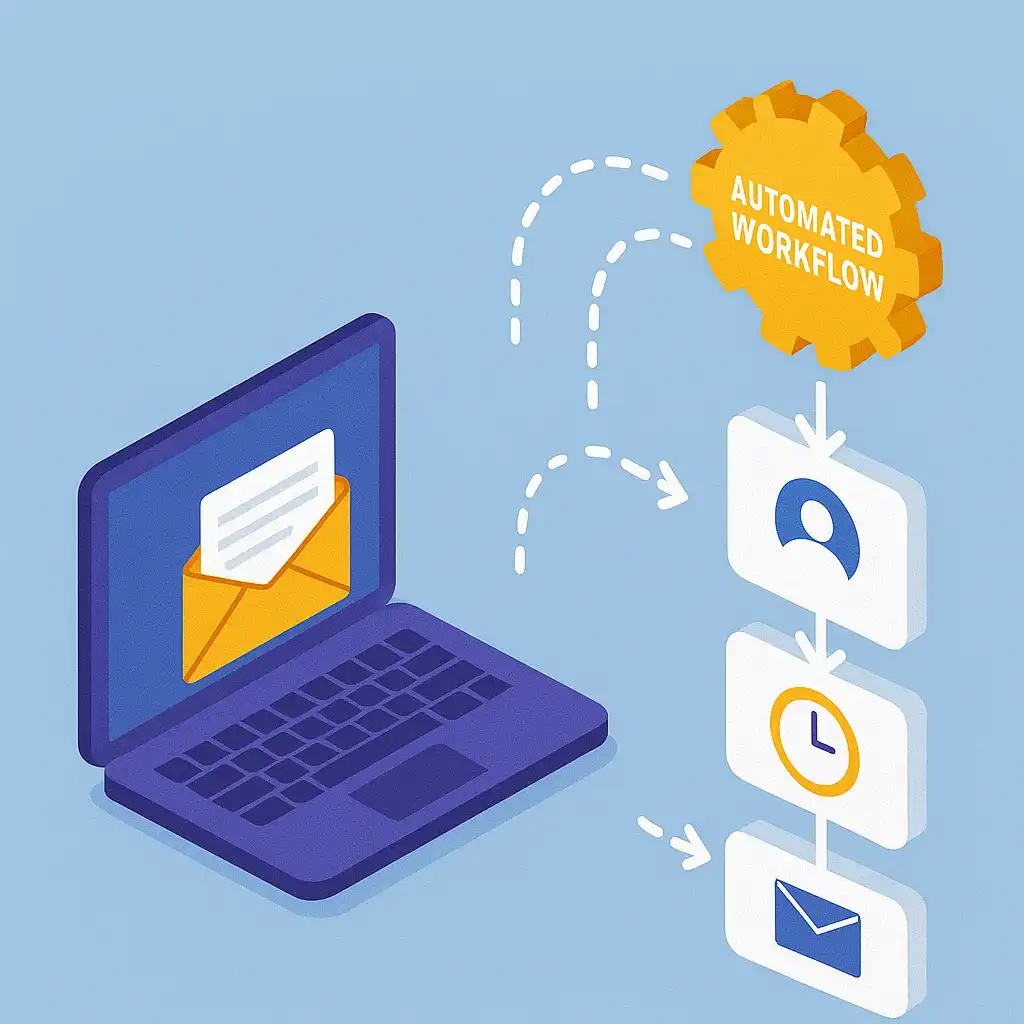
Email Marketing Automation for Hotels
Marketing automation transforms hotel email marketing from a time-intensive manual process into a scalable, efficient system that nurtures guest relationships automatically. By setting up triggered campaigns based on guest behavior and preferences, hotels can deliver timely, relevant messages that enhance the guest experience while driving revenue.
Set up automated welcome series for new email subscribers with hotel introduction, local area guide, and special offer. This sequence should span 5-7 emails over 2-3 weeks, gradually introducing your hotel’s unique features, nearby attractions, and exclusive member benefits. The first email should arrive immediately upon signup, followed by messages every 2-3 days featuring different aspects of the guest experience.
Create abandoned booking recovery campaigns triggered when guests start but don’t complete reservations. Send the first follow-up email within 2-4 hours while their interest remains high, featuring the specific room type and dates they were considering. Follow up again 24 hours later with additional incentives like free WiFi or breakfast inclusion, and send a final reminder 72 hours later with urgency messaging about limited availability.
Implement birthday and anniversary automation with personalized offers and upgrade opportunities. These campaigns achieve exceptionally high engagement rates because they feel personal and timely. Include special room rates, complimentary amenities, or experience packages that make celebrations memorable. Collect these important dates during the booking process or through preference center updates.
Design seasonal automated campaigns that trigger based on booking patterns, sending ski package emails to winter guests or beach promotions to summer visitors. Analyze historical booking data to identify when guests typically plan their return visits, then automatically send relevant seasonal offers 2-3 months before their usual booking window.
Configure loyalty program automation that sends point balance updates, tier advancement notifications, and reward redemption reminders. These emails keep your loyalty program top-of-mind and encourage continued engagement. Include personalized recommendations for point redemption based on past behavior and preferences.
Behavioral trigger automation based on website activity can recapture interested prospects. If someone visits your restaurant page multiple times, automatically send emails featuring dining specials and reservation links. Guests who browse spa services might receive automated wellness package promotions or treatment descriptions.
Set up re-engagement automation for subscribers who haven’t opened emails in 60-90 days. These campaigns should start with a simple “We miss you” message and progress to special win-back offers if initial attempts don’t generate engagement. Include a preference center link so inactive subscribers can adjust their email frequency rather than unsubscribing completely.
Best Practices for Hotel Email Design and Content
Subject Line Optimization
Subject lines determine whether your hotel email marketing campaigns succeed or fail, making optimization a critical priority for maximizing open rates and engagement. Effective subject lines balance personalization, urgency, and value proposition while avoiding spam trigger words and excessive punctuation.
Keep subject lines between 30-50 characters for optimal mobile display, considering that over 60% of emails are opened on mobile devices. Longer subject lines get truncated on small screens, potentially cutting off important information or calls-to-action. Test your subject lines across different devices and email clients to ensure consistent display.
Use personalization tokens like guest name or location to increase relevance and engagement. Examples include “Sarah, your Chicago weekend escape awaits” or “Welcome back to Miami, John!” However, avoid over-personalization that feels creepy or inappropriate. Stick to information guests willingly provided and use it contextually.
Create urgency with specific dates and limited-time offers that motivate immediate action. Phrases like “48 hours left: Spring break packages at Hotel Paradise” or “Last chance: Book by Friday for 30% off” clearly communicate time sensitivity. Always ensure that urgency claims are truthful to maintain trust and avoid spam filters.
A/B test different subject line approaches including questions, benefits, and emotional triggers. Questions like “Ready for your best vacation yet?” engage curiosity, while benefit-focused lines like “Save 25% on your next stay” clearly communicate value. Emotional triggers such as “Create unforgettable memories this weekend” appeal to the experiential nature of travel.
Avoid spam filter triggers including excessive capitalization, multiple exclamation points, and words like “FREE,” “URGENT,” or “ACT NOW.” These elements can send your carefully crafted emails directly to spam folders, regardless of content quality. Use spam checker tools to test subject lines before sending campaigns.
Email Design and Layout
Professional email design enhances your hotel’s brand reputation while ensuring messages display correctly across all devices and email clients. Effective hotel email marketing design balances visual appeal with functionality, creating engaging experiences that drive clicks and conversions.
Maintain a 60% text to 40% image ratio to avoid spam filters and ensure accessibility for all recipients. While beautiful photography showcases your property effectively, too many images can trigger spam filters and create problems for recipients with slow internet connections or accessibility needs. Include alt text for all images to support screen readers and display meaningful content when images don’t load.
Use responsive design templates that display correctly on mobile devices, tablets, and desktop computers. With most travelers reading emails on mobile devices, responsive design isn’t optional—it’s essential for campaign success. Test your templates across different screen sizes and email clients to ensure consistent experiences.
Include your hotel logo and brand colors consistently across all email campaigns for immediate brand recognition. Position your logo prominently in the header and use your brand color palette throughout the design. This consistency builds trust and reinforces brand memory for future booking decisions.
Place primary call-to-action buttons above the fold in contrasting colors with clear action words like “Book Now” or “View Availability.” Use colors that stand out from your brand palette while maintaining visual harmony. Make buttons large enough for easy mobile clicking and include secondary text links for backup accessibility.
Structure your email layout with clear hierarchy using headings, subheadings, and white space to guide readers through your content. Busy layouts overwhelm recipients and reduce engagement rates. Use scannable bullet points and short paragraphs that work well for mobile reading patterns.
Content Strategy
Effective hotel email marketing content focuses on guest benefits rather than property features, creating emotional connections that motivate booking decisions. Transform feature-focused language into benefit-driven messaging that resonates with travel motivations and desires.
Focus on guest benefits rather than hotel features by translating amenities into experiences. Instead of “We have a pool,” write “Relax in our heated pool with city skyline views.” Rather than listing room amenities, describe the comfort and convenience they provide: “Sink into luxury linens after a day exploring downtown attractions.”
Include social proof through guest testimonials, recent reviews, or awards received to build credibility and trust. Feature specific quotes from recent guests that highlight unique aspects of their experience. Include star ratings, award badges, or recognition from travel publications to reinforce your reputation for excellence.
Add local content showcasing nearby attractions, restaurants, and seasonal events to position your hotel as a local expert and destination authority. Guests appreciate insider tips that enhance their travel experience. Include information about walking distances, exclusive partnerships, or special access your hotel provides to local attractions.
Keep email copy concise with scannable bullet points and clear value propositions that respect busy travelers’ time. Use short paragraphs, descriptive headings, and visual elements to break up text. Front-load the most important information in case recipients only read the first few lines.
Hotel Email Marketing Campaign Ideas and Examples
Seasonal Promotional Campaigns
Seasonal email campaigns capitalize on natural travel patterns and holiday celebrations, creating timely opportunities to drive bookings during both peak and shoulder seasons. These campaigns should align with your local climate, events calendar, and target audience preferences while showcasing relevant amenities and experiences.
Summer getaway packages featuring pool access, outdoor dining, and local festival tickets appeal to leisure travelers seeking warm-weather experiences. Include information about extended pool hours, poolside service, outdoor concert venues, and air-conditioned comfort after hot days. Partner with local attractions to offer exclusive ticket packages or transportation services.
Holiday campaigns for Thanksgiving, Christmas, and New Year’s with family packages and celebration dinners target travelers seeking memorable holiday experiences away from home. Develop special menus, family-friendly activities, and traditions that create lasting memories. Include information about holiday decorations, special events, and extended family accommodations.
Spring break promotions targeting college markets with group booking discounts and late checkout options can fill rooms during traditionally slower periods. Offer packages that include activities popular with young adults while maintaining appropriate boundaries and safety measures. Include information about nearby entertainment, transportation options, and flexible policies for group bookings.
Fall foliage tours combined with cozy fireplace rooms and local hiking guides attract travelers seeking autumn experiences. Partner with local tour operators, include seasonal menus featuring local ingredients, and highlight outdoor amenities that showcase natural beauty. Provide information about peak foliage timing and photography opportunities.
Local Event and Experience Marketing
Local event email marketing positions your hotel as the preferred accommodation for visitors attending specific conferences, concerts, sports events, and cultural celebrations. These campaigns should highlight proximity advantages, special packages, and exclusive services that enhance the event experience.
Concert and sports event packages when major venues have performances include ticket procurement services, shuttle transportation, and late-night dining options. Create partnerships with venues to offer exclusive packages or preferred seating. Include information about sound-friendly room locations and late checkout options for post-event recovery.
Food and wine festival promotions highlighting hotel proximity and special tasting packages appeal to culinary travelers. Partner with festival organizers to offer exclusive experiences, cooking classes, or meet-and-greet opportunities with featured chefs. Include information about wine storage, dining reservations, and designated driver services.
Business conference and trade show campaigns targeting attendees with shuttle services and networking spaces address the specific needs of business travelers. Offer early arrival and late departure options, meeting room rentals, and networking reception spaces. Include information about business center amenities, reliable WiFi, and quiet zones for calls and meetings.
Wedding and special event marketing featuring ceremony packages, group rates, and planning services taps into the lucrative special events market. Develop comprehensive packages that include coordination services, catering options, and guest accommodation blocks. Highlight unique venue spaces, photography opportunities, and customization options.
Loyalty and VIP Program Emails
Loyalty program emails nurture your most valuable guest relationships while encouraging increased spending and repeat visits. These campaigns should make members feel special and appreciated while clearly communicating program benefits and exclusive opportunities.
Exclusive member previews for new amenities, restaurant openings, or renovated spaces create excitement and demonstrate insider access. Invite loyalty members to special preview events, complimentary tastings, or exclusive tours before public openings. Include professional photography that showcases new features and emphasizes the exclusive nature of early access.
Double points promotions during slow periods drive occupancy while hotel reward programs frequent guests with accelerated benefits. Time these promotions strategically to boost revenue during traditionally slower periods. Clearly communicate point earning opportunities and highlight how extra points bring members closer to reward redemptions.
VIP experience offers like private dining, spa treatments, or local guided tours provide memorable experiences that money can’t typically buy. Create experiences that showcase your hotel’s connections and expertise while providing Instagram-worthy moments that generate social media exposure. Include information about exclusivity and limited availability.
Member appreciation events with cocktail receptions, chef tastings, or local cultural experiences strengthen emotional connections with your brand. These events should feel genuinely appreciative rather than sales-focused. Include opportunities for members to provide feedback and suggestions for future improvements.
Email Marketing Metrics and Performance Tracking
Effective hotel email marketing requires consistent monitoring and optimization based on key performance metrics that directly correlate with revenue and guest satisfaction. Understanding these metrics enables data-driven decisions that improve campaign effectiveness and maximize return on investment.
Track open rates with industry averages ranging from 25-30% and optimize subject lines, sender names, and send times for improvements. Open rates indicate how well your subject lines resonate with recipients and whether your sender reputation remains strong. Test different subject line approaches, send times, and sender names to identify optimal combinations for your audience.
Monitor click-through rates with industry averages of 3-5% and test call-to-action placement, button colors, and offer relevance. Click-through rates measure how effectively your email content motivates action. Analyze which content types, offers, and designs generate the highest engagement to inform future campaign strategies.
Measure conversion rates from email to booking, aiming for 2-5% depending on campaign type and audience segment. Conversion tracking requires proper attribution setup to connect email clicks with actual bookings. Use unique tracking codes, dedicated landing pages, and integrated analytics to accurately measure email marketing’s contribution to revenue.
Calculate revenue per email sent and track lifetime value increases from email marketing efforts to demonstrate ROI. This metric helps justify marketing spend and guide budget allocation decisions. Track both immediate bookings and longer-term guest value to capture email marketing’s full impact on hotel revenue.
Monitor unsubscribe rates, keeping them below 2%, and spam complaints to maintain sender reputation and deliverability. High unsubscribe rates indicate content relevance problems or excessive sending frequency. Use preference centers to let subscribers adjust frequency rather than unsubscribing completely.
Track engagement patterns across different segments to identify high-performing audience groups and content types. Analyze which segments respond best to different campaign types, offers, and messaging approaches. Use this data to refine segmentation strategies and allocate resources to highest-performing segments.
Measure deliverability rates and inbox placement to ensure your emails reach intended recipients. Use deliverability monitoring tools to track spam folder placement and identify potential reputation issues before they impact campaign performance. Maintain clean email lists and follow best practices to preserve sender reputation.
Choosing the Right Email Marketing Platform for Hotels
Selecting the appropriate email marketing software for your hotel requires careful consideration of hospitality-specific features, integration capabilities, and scalability options that support both current needs and future growth. The right platform becomes a central hub for guest communication and revenue generation.
Prioritize platforms with hospitality-specific templates, property management system integrations, and revenue attribution tracking. Generic email platforms lack the specialized features that hotels need for effective guest communication. Look for platforms that understand the guest journey and provide templates designed for pre-arrival, in-stay, and post-stay communications.
Ensure the platform can integrate with your booking engine, CRM, and property management system for seamless data flow. Manual data entry and disconnected systems create inefficiencies and missed opportunities. Choose platforms that offer native integrations or robust API capabilities that connect with your existing technology stack.
Look for advanced segmentation capabilities based on booking data, stay history, and guest preferences. Hotels need more sophisticated segmentation than basic demographic filters. Seek platforms that can segment based on booking source, room type preferences, stay frequency, spending patterns, and custom fields that capture guest preferences.
Choose platforms offering automation workflows specifically designed for the guest journey from inquiry to post-stay follow-up. Generic automation tools require extensive customization to work effectively for hotels. Look for pre-built workflows for common hotel scenarios like abandoned bookings, pre-arrival sequences, and post-stay follow-up campaigns.
Verify the platform provides detailed analytics including revenue tracking, ROI measurement, and campaign attribution. Hotels need to prove email marketing’s impact on direct bookings and revenue. Choose platforms that integrate with Google Analytics, provide robust reporting dashboards, and offer revenue attribution features that connect email engagement with booking behavior.
Consider scalability and pricing models that accommodate seasonal fluctuations in your email database size. Hotels often experience significant seasonal variations in subscriber counts and email volume. Choose platforms with flexible pricing that doesn’t penalize you for natural business fluctuations.
Evaluate customer support quality and availability, particularly for technical integrations and deliverability issues. Email marketing platforms require ongoing support for technical issues, deliverability questions, and strategy guidance. Choose providers known for responsive support and hospitality industry expertise.
Advanced Email Marketing Strategies for Hotels
Advanced hotel email marketing strategies leverage sophisticated technology and data analysis to create highly personalized, profitable campaigns that maximize guest lifetime value and operational efficiency. These techniques require more complex setup but deliver significantly improved results for hotels committed to email marketing excellence.
Implement dynamic hotel content that changes based on guest location, weather, or past booking behavior to create highly relevant experiences. Dynamic content allows single email templates to display different information for different recipients. Show local weather forecasts, nearby events, or personalized recommendations based on previous stays and expressed preferences.
Use behavioral triggers like website page visits or abandoned cart activities to send targeted follow-up emails that capture interested prospects. Set up automation that tracks specific page visits, such as spa services or dining menus, and sends relevant follow-up emails with special offers or additional information. This approach captures interest when it’s highest and guides prospects toward booking decisions.
Create win-back campaigns for guests who haven’t stayed in 12+ months with special incentives and personalized offers that reactivate dormant relationships. Analyze inactive guest segments to understand why they stopped booking and design campaigns that address common concerns. Include surveys to gather feedback and exclusive offers that provide compelling reasons to return.
Develop referral programs encouraging past guests to recommend friends and family through email campaigns that reward both referrer and referee. Create automated sequences that thank guests for referrals, track successful bookings, and deliver promised rewards. Use social proof and guest testimonials to encourage sharing among social networks.
Test send time optimization based on guest time zones and historical engagement patterns to maximize open rates and engagement. Analyze your email performance data to identify optimal sending times for different guest segments. Business travelers might prefer early morning emails, while leisure guests might engage better with evening sends.
Implement predictive analytics to identify guests most likely to book based on historical patterns and current behavior. Use data science techniques to score prospects and allocate marketing resources to highest-value opportunities. This approach improves campaign efficiency and maximizes return on marketing investment.
Use cross-channel integration to coordinate email campaigns with social media, SMS, and retargeting advertisements for cohesive guest experiences. Create unified messaging across all touchpoints that reinforces key offers and maintains consistent brand voice. Track guest interactions across channels to understand the complete customer journey and optimize touchpoint effectiveness.
Advanced personalization using machine learning algorithms can recommend specific room types, amenities, and experiences based on individual guest preferences and similar guest behavior patterns. These systems continuously learn from guest interactions and booking decisions to improve recommendation accuracy over time.
Email marketing for hotels represents a highly profitable marketing channel that drives direct bookings, reduces OTA dependency, and builds lasting guest relationships. Success requires strategic planning, consistent execution, and continuous optimization based on performance data and guest feedback.
The most effective hotel email marketing strategies combine multiple campaign types, sophisticated segmentation, and marketing automation to deliver relevant, timely messages throughout the guest journey. From initial awareness through post-stay follow-up, email provides hotels with direct access to their most valuable audience.
Start by building a robust email database through multiple touchpoints and compelling incentives. Focus on creating valuable content that enhances the guest experience while driving profitable actions. Use segmentation and automation to deliver personalized messages at scale, and consistently track performance metrics to optimize results.
The hotel industry continues evolving rapidly, but email marketing remains a constant opportunity for properties that commit to excellence in guest communication. Hotels that master email marketing gain sustainable competitive advantages through stronger guest relationships, higher direct booking percentages, and improved guest lifetime value.
Begin implementing these strategies today by auditing your current email marketing efforts and identifying the biggest opportunities for improvement. Whether you’re starting from scratch or optimizing existing campaigns, email marketing provides hotels with one of the most reliable paths to increased revenue and guest loyalty in 2024 and beyond.
